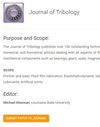Study on Lubricating Performance of the Bubbly Oil under High Shear Rate, Part 1: Generation Method and Viscosity Measurement of the Bubbly Oil
IF 3
3区 工程技术
Q2 ENGINEERING, MECHANICAL
引用次数: 0
Abstract
Bubbly oil lubrication is a type of lubrication method which has a high potential for application. However, the lubricating performance of the bubbly oil has not been thoroughly considered. This paper aims to investigate the lubricating performance of the bubbly oil including generation of the bubbly oil, viscosity characteristics of the bubbly oil and the application study of the bubbly oil lubrication. Due to space limitation, the work is divided into two parts. Part 1 focuses on the generation method of the bubbly oil, observation of the bubbly oil and the measurement of viscosity characteristics under a high shear rate. Part 2 focuses on the application study of the bubbly oil lubrication in high-speed bearing. A generation method for the bubbly oil was proposed by a combination of the dispersed-air method and the pressurized dissolution one. An experiment setup for generating the bubbly oil, an observation system for the bubbly oil and a specially-designed viscometer for the bubbly oil were developed. The research results show that the generation method for the bubbly oil is of high efficiency and stability and the observation system is operational.高剪切速率下气泡油的润滑性能研究,第一部分:气泡油的产生方法及粘度测量
气泡油润滑是一种极具应用潜力的润滑方式。然而,气泡油的润滑性能并没有得到充分的考虑。本文旨在研究气泡油的润滑性能,包括气泡油的产生、气泡油的粘度特性以及气泡油润滑的应用研究。由于篇幅所限,本文分为两部分。第一部分主要介绍了泡沫油的产生方法、泡沫油的观察和高剪切速率下粘度特性的测量。第二部分重点研究了气泡油润滑在高速轴承中的应用。提出了一种分散空气法和加压溶解法相结合的气泡油生成方法。研制了气泡油生成实验装置、气泡油观测系统和专门设计的气泡油粘度计。研究结果表明,气泡油生成方法高效、稳定,观测系统运行良好。
本文章由计算机程序翻译,如有差异,请以英文原文为准。
求助全文
约1分钟内获得全文
求助全文
来源期刊
CiteScore
4.20
自引率
12.00%
发文量
117
审稿时长
4.1 months
期刊介绍:
The Journal of Tribology publishes over 100 outstanding technical articles of permanent interest to the tribology community annually and attracts articles by tribologists from around the world. The journal features a mix of experimental, numerical, and theoretical articles dealing with all aspects of the field. In addition to being of interest to engineers and other scientists doing research in the field, the Journal is also of great importance to engineers who design or use mechanical components such as bearings, gears, seals, magnetic recording heads and disks, or prosthetic joints, or who are involved with manufacturing processes.
Scope: Friction and wear; Fluid film lubrication; Elastohydrodynamic lubrication; Surface properties and characterization; Contact mechanics; Magnetic recordings; Tribological systems; Seals; Bearing design and technology; Gears; Metalworking; Lubricants; Artificial joints

 求助内容:
求助内容: 应助结果提醒方式:
应助结果提醒方式:


